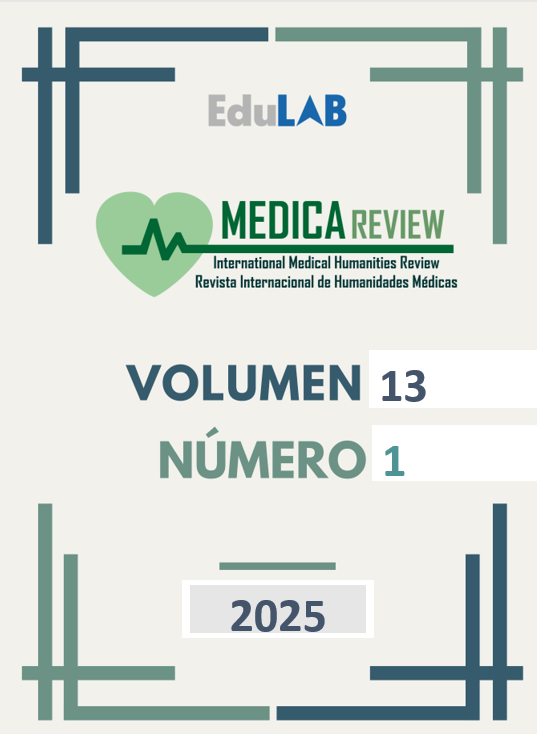La teoría psicodinámica desde una perspectiva psicológica evolucionista.
Una visión evolucionista de los procesos inconscientes
DOI:
https://doi.org/10.62701/revmedica.v13.5463Palabras clave:
psicodinámica,, psicología evolucionista, mecanismos de defensa, conflictos, inconscienteResumen
La integración del enfoque psicodinámico con la psicología evolucionista ofrece una visión más amplia de la mente humana. La psicología evolucionista explica patrones de pensamiento y conducta como adaptaciones evolutivas, mientras que la psicodinámica se enfoca en conflictos inconscientes y mecanismos de defensa. Combinarlas permite entender cómo procesos como los deseos reprimidos o la lucha entre ello, yo y superyó podrían haber evolucionado para facilitar la supervivencia y la cohesión social. También se reconsideran los mecanismos de defensa como estrategias adaptativas. La terapia basada en la mentalización se propone como puente clínico entre ambas perspectivas teóricas.
Estadísticas globales ℹ️
|
669
Visualizaciones
|
344
Descargas
|
|
1013
Total
|
|
Citas
Bargh, J. A., & Morsella, E. (2008). The unconscious mind. Perspectives on Psychological Science, 3(1), 73–79. https://doi.org/10.1111/j.1745-6916.2008.00064.x
Barton, R. A., & Venditti, C. (2014). Rapid Evolution of the Cerebellum in Humans and Other Great Apes. Current Biology, 24(20), 2440-2444. https://doi.org/10.1016/j.cub.2014.08.056
Bateman, A., & Fonagy, P. (2018). Tratamiento basado en la mentalización para trastornos de la personalidad. Una guía práctica. Desclée de Brouwer.
Bowlby, J. (1969). Attachment and loss: Vol. 1. Attachment. Basic Books.
Buss, D. M. (2019). Evolutionary psychology: The new science of the mind (6ª ed.). Routledge. https://doi.org/10.4324/9780429061417
Del Giudice, M. (2009). Sex, attachment, and the development of reproductive strategies. Behavioral and Brain Sciences, 32(1), 1–21. https://doi.org/10.1017/S0140525X09000016
Dunbar, R. I. M. (1998). The social brain hypothesis. Evolutionary Anthropology: Issues, News, and Reviews, 6(5), 178–190. https://pubmed.ncbi.nlm.nih.gov/19575315/
Freud, S. (1920). Beyond the pleasure principle. Hogarth Press.
Haselton, M. G., & Nettle, D. (2006). The paranoid optimist: An integrative evolutionary model of cognitive biases. Personality and Social Psychology Review, 10(1), 47–66. https://doi.org/10.1207/s15327957pspr1001_3
Herculano-Houzel, S. (2009). The human brain in numbers: A linearly scaled-up primate brain. Frontiers in Human Neuroscience, 3, 31. https://doi.org/10.3389/neuro.09.031.2009
Kenrick, D. T., Griskevicius, V., Neuberg, S. L., & Schaller, M. (2010). Renovating the pyramid of needs: Contemporary extensions built upon ancient foundations. Perspectives on Psychological Science, 5(3), 292–314. https://doi.org/10.1177/1745691610369469
Lewis, DMG, Al-Shawaf, L., y Buss, DM (2020). Psicología evolutiva de la personalidad. En P. J. Corr y G. Matthews (Eds.), The Cambridge Handbook of Personality Psychology (págs. 223-234). Cambridge: Cambridge University Press.
Malafouris, L. Las personas son EXTRAÑAS: hacia una arqueología filosófica del yo. Phenom Cogn Sci (2024). https://doi.org/10.1007/s11097-024-10002-1
Mikulincer, M., & Shaver, P. R. (2007). Attachment in adulthood: Structure, dynamics, and change. Guilford Press.
Öhman, A., & Mineka, S. (2001). Fears, phobias, and preparedness: Toward an evolved module of fear and fear learning. Psychological Review, 108(3), 483–522. https://doi.org/10.1037/0033-295X.108.3.483
Reader, S. M., & Laland, K. N. (2002). Social intelligence, innovation, and enhanced brain size in primates. Proceedings of the National Academy of Sciences, 99(7), 4436–4441. https://doi.org/10.1073/pnas.062041299
Revonsuo, A. (2000). The reinterpretation of dreams: An evolutionary hypothesis of the function of dreaming. Behavioral and Brain Sciences, 23(6), 877–901. https://doi.org/10.1017/S0140525X00004015
García, R. (2022). El narcisismo en Sigmund Freud.
Van Essen, D. C., et al. (2012). The Human Connectome Project: A data acquisition perspective. NeuroImage, 62(4), 2222–2231. https://doi.org/10.1016/j.neuroimage.2012.02.018
Tonna, M. (2024). The evolution of symbolic thought: At the intersection of schizophrenia psychopathology, ethnoarchaeology, and neuroscience. Culture, Medicine and Psychiatry, 48(4), 900–917. https://doi.org/10.1007/s11013-024-09873-5
Wrangham, R. W. (2009). Catching fire: How cooking made us human. Basic Books.
Zadra, A., & Donderi, D. C. (2000). Nightmares and bad dreams: Their prevalence and relationship to well-being. Journal of Abnormal Psychology, 109(2), 273–281. https://doi.org/10.1037/0021-843X.109.2.273
Descargas
Publicado
Cómo citar
Número
Sección
Licencia
Aquellos autores/as que publiquen en esta revista, aceptan los términos siguientes:
- Los autores/as conservarán los derechos morales sobre la obra y cederán a la revista los derechos comerciales.
- Transcurrido un año desde su publicación, la versión del editor pasará a estar en acceso abierto en la web de la editorial, pero la revista mantendrá el copyright de la obra.
- En el caso de que los autores deseen asignar una licencia abierta Creative Commons (CC), podrán solicitarla escribiendo a administracion@edulab.es









